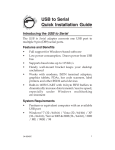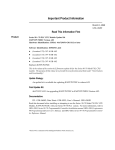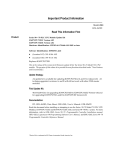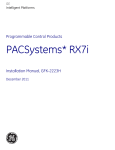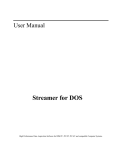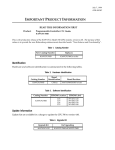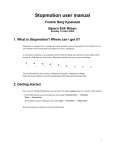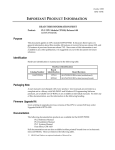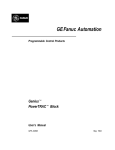Download Series 90-70 CPU Update Kit, IC697CPU771NU, GFK
Transcript
Important Product Information July 1, 1992 GFK–0424P Read This Information First Product: Series 90–70 PLC CPU Module Update Kit IC697CPU771NU Version 4.02 Hardware Identification: CPFB2 44A731660–G01 R02 or later Software Identification: EPROM Label D (Location U67): 395–016A 4.02 D (Location U66): 395–017A 4.02 Replaces IC697CPU771M This is the release of the version 4.02 firmware update kit for the Series 90–70 Model 771 CPU module, catalog number IC697CPU771M. A separate update kit is available for updating previous versions of the 771 CPU module. The purpose of this release is to provide the new functions described under ”New Features and Functionality”. Update Stategy: An update kit is available for updating IC697CPU771M to release 4.02. Field Update Kit: 44A731237–G01 for upgrading IC697CPU771M to IC697CPU771NU Version 4.02. Documentation: IPI: GFK–0424P; Data Sheet: GFK–0349C; User’s Manual: GFK–0262D Read this document before installing or attempting to use the Series 90–70 Model 731 PLC CPU Modules, IC697CPU771NU with your Series 90–70 PLC system. For more information, refer to GFK–0262, Series 90–70 Programmable Controller Installation manual, GFK–0263, Logicmaster 90 Programming Software User’s Manual, and GFK–0265, Series 90–70 Programmable Controller Reference Manual. Series 90 is a trademark of GE Fanuc Automation North America, Inc. Important Product Information 2 GFK–0424P Operating Notes: Logicmaster Compatibility 1. This release of the PLC CPU module is compatible with Logicmaster 90–70 version 2.04 or later. However, version 4.01 or later is required to gain access to all of the CPU’s features and functionality. To work around a compatibility problem with serial Logicmaster 90–70, the PLC will return 3.42 as its version to all serial Logicmaster 90–70 products (WSI and Standard COM) release 3.04 and earlier. Reference Tables 2. When this CPU module is used with release 4 or later of Logicmaster 90–70, reference tables will not be changed during any STORE operation unless the user specifically selects storing of reference tables. Foreign VME Modules 3. Logicmaster 90–70 Release 4 allows foreign VME modules to be configured for four modes: BUS INTERFACE, INTERRUPT ONLY, FULL MAIL, and REDUCED MAIL. However, the Release 4 CPU module supports only the BUS INTERFACE MODULE mode. The other three modes should not be configured. Maximum PLC Sweep 4. In systems configured for Genius Bus Redundancy a complete PLC sweep must be executed every 500 ms or less, even though it is possible to configure the watchdog timer to higher limits. This means that resetting of the watchdog timer with Service Request #8 cannot be done indefinitely. Serial Communications 5. The following operational restrictions exist for the Serial Communications feature: 1. Serial communications may add up to 5 ms of time to any given sweep. This should be taken into account when setting the watchdog timer. 2. The following procedure is recommended when changing baud rates in the PLC and the WSI board. First enter the configuration package and change the baud rate on the PLC, then store the new configuration. Now power off the PLC and then go to the WSI setup screen and change the WSI baud rate. Finally, power the PLC back on. 3. The link idle time setting in Logicmaster 90–70 Config for Serial Communications should not be set to less than 10 seconds – otherwise a communications failure will occur when storing the config to the PLC. LM90/WSI Attach 6. Do not connect or disconnect the WSI/BTM cable while the PC/Workmaster host is powered–on. This action may cause a running PLC to Stop. Expansion Rack ID 7. The expansion racks for the Series 90–70 PLC are shipped with the rack ID strapped for rack 0 (the main rack). If the rack jumper is not changed the PLC will not recognize the rack at all and may not properly identify the error. Important Product Information GFK–0424P Expansion Rack Cable 8. Do not connect or disconnect the expansion rack cable while the CPU is running. This will cause the PLC to go to the STOP/HALT mode. Expansion Rack Power 9. Expansion racks should not be powered up at the same time that the main rack is powered up, or they should be powered up after the main rack has completed its power–up initialization. Memor y Usage 10. A general rule–of–thumb for memory usage is 48 bytes per I/O point plus register memory in bytes. Timer Operation 11. Care should be taken when timers (ONDTR, TMR, and OFDTR) are used in sub– blocks that are NOT called every sweep. The timers accumulate time across calls to the sub–block unless they are reset. This means that they function like timers operating in a program with a much slower sweep than the timers in the main program block. For program blocks that are inactive for large periods of time, the timers should be programmed in such a manner as to account for this catch up feature. Similiar to this are timers that are skipped because of the use of the JUMP instruction. Timers that are skipped will NOT catch up and will therefore not accumulate time accurately. STOP I/O SCAN 12. When a Release 1 folder is converted to Release 3, the STOP mode changes from STOP/IODISABLEDtoSTOP/IOSCAN. To change this, zoom into the PLC CPU slot in I/O configuration and change the STOP mode. Large Programs 13. Logic programs that were very close to the maximum size limit in Release 2 may not store to a Release 3 or 4 PLC. To work around this you must make the program snaller. Constant Sweep 14. Constant Sweep time, when used, should be set to about 10 ms greater than the normal sweep time to avoid any oversweep conditions when monitoring or performing on–line changes with the programmer. The smallest valid constant sweep time setting is 25 milliseconds. Window completion faults will occur if the constant sweep setting is not high enough. Interaction of Logicmaster 90–70 with Closed Programming Window 15. The Logicmaster 90–70 Sweep Control and Monitor screen cannot be used to change the PLC’s Sweep Modes or timers (Constant Sweep Time, Program Window Times, etc.) while the program window is closed. Use Service Requests #1 through #4 to perform these functions. 3 Important Product Information 4 GFK–0424P Caution Also, Logicmaster 90–70 cannot be used to change the PLC mode (STOP, RUN, etc.) while the programming window is closed. Use the toggle switch on the CPU module instead. Bus Transmitter 16. Bus Transmitter Module, version IC697BEM713A, should be installed to the right of all other interrupt source modules (Genius Bus Controllers, Series 90–70 discrete Input modules, and Programmable Coproccessor Modules) to avoid an informational System Configuration Mismatch Fault ”Board to right of Rev A BTM” from being logged into the fault table and a single scan 50 ms scan time increase from occurring. The frequency of this scan increase is 1 to 2 times per hour for single rack systems and increases with additional racks and interrupt sources. This condition exists only with the ”A” version of the BTM and has been corrected in the IC697BEM713B and later versions. Problems Resolved by this Upgrade: 1. Series 90–30 and 90–70 PLCs will now work on the SNP miltidrop cable when their configurations for parity are not the same. However, version 3.03 or later of the Series 90–30 PLC is required. 2. The PLC no longer ignores the comm buffer size specified by the SNP master device. Therefore, SNP masters can use comm buffers that are smaller than 8K bytes. 3. The T3 and T3i SNP timeouts are now enabled. 4. The PLC now responds correctly to the SNP masters’s inquiry message. 5. The PLC now sends a receive ACK to the SNP master when the PLC requires more than 10 seconds to respond to a request. 6. System status bit FST_EXE (%S121) will no longer appear to be overridden ON when a program block executes an excessive number of recursive calls to itself. 7. Smart modules now get logged as ”Additional, Reset, or Extra” modules in the PLC fault table when power is cycled on the main rack only and the modules are not part of the configuration that was stored from Logicmaster 90–70. 8. The PLC will now power–up in STOP/NOIO if the toggle switch is in the STOP position and Logicmaster 90–70 had commanded the PLC to STOP/NOIO before power–down. This occurs even when the PLC is configured for STOP/IOSCAN. 9. The PLC no longer loses communications with an SNP master when the master sends an abort request during a load/store operation. 10. Serial Logicmaster 90–70 no longer loses communications with the PLC when a fault table is cleared. 11. Transitional contacts now work correctly when associated with references in the Q output array of the Shift Left/Right and Rotate Left/Right functions.. 12. SVC_REQ function #16 (Read Elapsed Time Clock) now returns the correct result when used with bit memory (%T, %M, %Q, %I). Important Product Information GFK–0424P 13. The Mixed Multiply and Divide functions will now log an ”Indirect Reference Out of Range” fault when an indirect reference out of range condition occurs on a double word parameter. 14. Executing a call to a program block inside a program block that was called by an I/O interrupt will now cause a diagnostic application fault instead of crashing the PLC. The processing of the interrupt is aborted and the PLC continues to execute in RUN mode. 15. The MOD_DINT function now produces the correct result when parameter I1 = 0 and parameter I2 is >32,767. 16. Quick power cycles (power off for 5 seconds or less) with the battery disconnected will now work properly. 17. The PLC will now operate correctly when the IN parameter on the Shift Register Word function is a constant. 18. PCMs in expansion racks will now power–up properly when the expansion rack is power–cycled while the main rack maintains power. 19. The PLC will no longer fail when the number of declared program blocks is four more than a multiple of eight. 20. The PID function’s CV output now ramps up/down at the expected rate. 21. The execution of an I/O interrupt no longer sets the wrong %I bit when the program logic is stored to the PLC before the configuration is stored to the PLC. 22. The PLC no longer allows an OEM key to be set when passwords are disabled. New Features and Functionality: Genius Redundancy 1. The PLC will now support Genius Bus Controller redundancy (two GBCs in the same CPU sharing blocks) in hot–standby and dual–bus configurations. The hot– standby configuration protects against bus controller failures. The dual–bus configuration protects against bus controller and media failures. Release 4 or later of the Genius Bus Controller is required by this feature. Background Checksum 2. The PLC will continuously calculate a checksum over the user’s program to ensure the integrity of the program. The user can use the Logicmaster 90–70 Configuration software or the Service Request function block to regulate the amount of the checksum that is calculated each sweep. C Program Blocks 3. You can now program your applications with Microsoft C 6.00. Program Block calls in the main block and LD program blocks can call program blocks that have been programmed in the C language. Up to seven parameter pairs can be passed to the C block. 5 Important Product Information 6 GFK–0424P Performance Improvements 4. The sweep time impact of the Genius Bus Controller has been reduced. For all CPU models, the sweep time impact for GBC overhead has been reduced by 50%. The sweep impact due to Genius blocks has not changed. The sweep time impact of most function blocks has been improved. In particular, timers and counters have been improved by 12% and the MOVE function has been improved by 22%. User Fault Logging 5. The user can log a fault in the PLC fault table from the ladder program. The SVC_REQ function now allows the user to define a fault that will place an ASCII text message in the fault table and optionally set a bit in %SA memory. Single–Sweep Debug 6. The PLC now has the ability to execute a single sweep of the user program. This provides the user with a tool to check out the execution of the program one sweep at a time. This sweep can be executed as a normal sweep or as a first scan sweep. Timed Interrupts 7. The PLC will support the execution of program blocks on a timed, periodic basis. A program block declared in this manner will periodically interrupt the normal sweep to execute one sweep of the program block. This feature is very much like the existing I/O interrupt feature except that the program block execution is triggered by a free–r unning timer instead of the transition of an input point. Array Move Function 8. This function allows the user to extract one or more elements from a data array and copy them to another array. It supports arrays of data elements of the following types: BYTE, INT, WORD, UINT, DWORD, and DINT. Array Search Function 9. This set of functions allows the user to search an array for a data element that is equal, not equal, greater than, greater or equal, less than, or less than or equal to a specified value. These functions support the same data types that are supported by the Array Move function. FOR/NEXT Function 10. This function allows the user to iteratively execute any number of ladder logic rungs within a program block. The EXIT_FOR function provides a way to prematurely terminate the iterations. New VME Access Functions 11. The VME_CONFIG_RD and VME_CONFIG_WRT functions allow foreign VME modules to be accessed by one of five methods: word, byte, odd byte only, single word, and single byte. The access method, AM code, and VME address for the VME Important Product Information GFK–0424P module are specified when the module is configured with Logicmaster 90–70. These functions are being offered in addition to the existing VME Read and Write functions. Restrictions and Open Problems: 1. If an expansion rack powers up while the CPU in the main rack is in the RUN mode, the slot fault contacts will prematurely indicate that the modules in the expansion rack are not faulted before they complete their power up. 2. In a multi–rack system, false LOSS OF RACK faults may occur when the system loses power. If this fault is configured to be fatal, the system will power–up in STOP mode. 3. The SORT function cannot be used in an interrupt block and in another part of the program at the same time. If a SORT function is interrupted by an interrupt block that executes a SORT function, the SORT in the interrupt block will log a User Application fault, but not execute. The interrupted SORT in the other part of the program will produce the correct result. 4. If a program block that is activated by an I/O interrupt calls another program block, a User Application fault will occur and the PLC will go to STOP mode. 5. Since there are no tasks that run in the PLC’s background window, changes made to the Background Window Timer with Logicmaster 90–70 will have no effect. 6. CPU models IC697CPU771E, F, G, JX, and KX that are upgraded for Release 4.02 may experience improper execution of the rung that follows the EXIT_FOR instruction. The work–around for this problem is to insert a rung containing a single MOVE_INT instruction immediately after all EXIT_FOR instructions. 7. When there is no logic stord in a CPU module the %Q and %M tables will be cleared when the CPU is placed in RUN mode. In this context ”no logic stored” means that no program had ever been stored or that the clear function on Logicmaster 90–70 had been used to clear logic and configuration. 8. Option modules will not be able to return the completion status for COMM_REQ functions when the PLC has a password set at level 2. 9. When the Bit Sequencer sequences from one step to another, the negative transitional contact that corresponds to the original step is not set. The transition contact for the new step is set and remains set until the sequencer sequences to the next step. This operation is identical to the operation of the previous versions of the CPU firmware. 10. When a Release 3 or earlier Genius Bus Controller is present in a PLC, but is not present in the configuration stored to the PLC from Logicmaster 90–70, the Bus Controller will log on to the Genius Bus at serial bus address 0. Release 4 or later Bus Controllers will not log on to the bus at all in this situation. GE Fanuc Automation North America, Inc., Charlottesville, Virginia 7







